Woodturning Training Break For Inspiration and Refinement
May also be viewed via YouTube, Vimeo, or Facebook. Best right here!
I could not take video during the workshop, so here is a summary of the week’s activity.
The woodturning workshop: Craft Supplies USA; Intermediate Taught by Kirk DeHeer. Kirk is a practical yet highly skilled turner. There’s a lot I can learn from him.
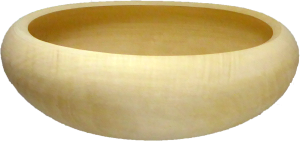 Poplar calabash bowl
Poplar calabash bowl
A calabash bowl follows the shape of a calabash squash as if the bowl was cut from the gourd. The wood was mounted on a screw chuck to form the exterior including a large (about 5″) dovetail tenon and a step to guide my eye in forming the curve. The bowl is reversed into a 4 jaw chuck for hollowing. The most difficult part is undercutting the reverse curve. To finish the bottom, a new block of wet or green wood is mounted to a screw chuck on the lathe. Then cut a tenon on this wood as a tight fit to the calabash bowl. Be sure to measure the thickness of the bottom before mounting to the jam chuck. Then gently remove the excess wood from the bottom. This bowl is 10″ by 4″; never sanded; no finish applied. It will warp as it drys.
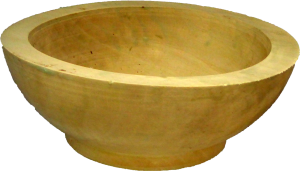 Silver Maple bowl
Silver Maple bowl
This was the wood for the jam chuck for the poplar calabash. After fulfilling its duty as a jam chuck, I rough turned the bowl leaving the walls about 1″ thick. Exterior turned on a screw chuck; Interior turned while mounted with a 5″ dovetail tenon to a four jaw chuck. This bowl is 10″ by 3″ and coated with Tree Saver to prevent cracking while drying.
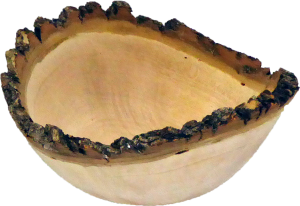 Maple Natural Edge
Maple Natural Edge
These two bowls are not finished but not by much. The wood was first mounted with a two prong drive center driven into the bark edge. Then while mounted between centers, the bowl is rough turned before balancing the bark edges. Then cut a mounting tenon and refine the exterior. After reversing the bowl, hollow the interior. Then leave for a day to allow surface moisture to evaporate before sanding to final grit. Finally, the bowl is reversed again onto a padded disk to serve as a friction chuck. While held between the friction chuck and the live center, refine the foot but I left the central wood nub. After the bowl drys for another month or two, I will use the nub to center the tail stock for a final sanding. After cutting off the nub, I’ll sand the bottom center with 2″ pads on the drill press. 8″ x 4″ Not quite finished.
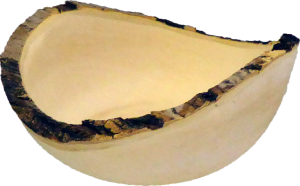 Poplar Natural Edge
Poplar Natural Edge
This bowl is formed the same way as the Maple bowl. The bark for each bowl was treated with CA glue to stabilize the bark. 8″ x 4″ Not quite finished.
Maple End Grain Box
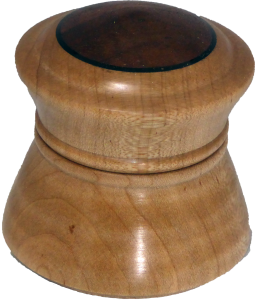 A favorite of mine. This one is about 3″ by 3″. The interior is finished with Scratch Freee wax to avoid any residual smell. The exterior is finished with brushing lacquer. Boxes are a great exercise in mounting the wood. 1st (between centers) to rough turn the wood and form tenons; 2nd(chuck) to finish roughing and part the the bottom from the top; 3rd (chuck) to hollow the top; 4th (chuck) to fit the tenon to the top; 5th (chuck) top and bottom together with a friction fit to shape the exterior and complete the inlay and part off the bottom; 6th (chuck) using the scrap from the bottom, form a jamb chuck to hold the bottom while refining the bottom. The exterior is finished with brushing lacquer.
A favorite of mine. This one is about 3″ by 3″. The interior is finished with Scratch Freee wax to avoid any residual smell. The exterior is finished with brushing lacquer. Boxes are a great exercise in mounting the wood. 1st (between centers) to rough turn the wood and form tenons; 2nd(chuck) to finish roughing and part the the bottom from the top; 3rd (chuck) to hollow the top; 4th (chuck) to fit the tenon to the top; 5th (chuck) top and bottom together with a friction fit to shape the exterior and complete the inlay and part off the bottom; 6th (chuck) using the scrap from the bottom, form a jamb chuck to hold the bottom while refining the bottom. The exterior is finished with brushing lacquer.
While finishing the top, I inlaid a walnut insert. After that glue hardened, I cut a small groove around the perimeter of the inlay then filled the groove with black CA glue. When that glue was hard, I smoothed the glue and finished the top.
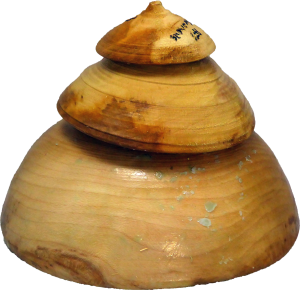 Sycamore Cored Bowls
Sycamore Cored Bowls
The wet wood is first mounted to a screw chuck to form the exterior and with a large 5″ tenon. Then with the wood reversed onto the chuck and using McNaughton coring tools, cut out the small bowl. Then cut out the middle bowl. While still mounted to the chuck refine the interior of the largest bowl just a little. After the surface moisture has evaporated, coat with Tree Saver to prevent cracking. Once the wood is dry measured by when it no longer loses weight, each bowl will be remounted and returned. The largest bowl is 12″ x 4″.
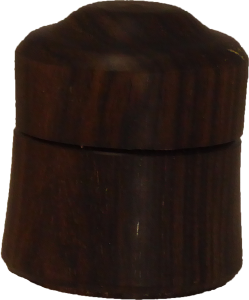 African Blackwood Threaded Box
African Blackwood Threaded Box
African Blackwood is a good choice for threading as it is very dense. It is turned similarly to a non-threaded box. The difference is threading – a process that I cannot explain in print. This 1.5″ x 2.5″ box is finished with Scratch Free wax.
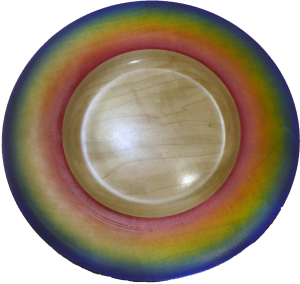 Maple Dyed Platter
Maple Dyed Platter
I started this platter one day with a rough forming of the back side including an expansion mortise for the chuck. Then it rested two days to allow stresses to subside. Then it was remounted to the lathe to refine the bottom side before reversing onto the four jaw chuck to form the rim. After sanding to final grit, I used an airbrush to spray alcohol based blue, red, and yellow dye onto the rim. The three bands bleed together to form green and orange bands. After spraying with rattle-can lacquer, I continued on to hollow the center. This 14″ platter is finished with spray lacquer.
It was a great workshop with a great instructor. I may do it yet again.